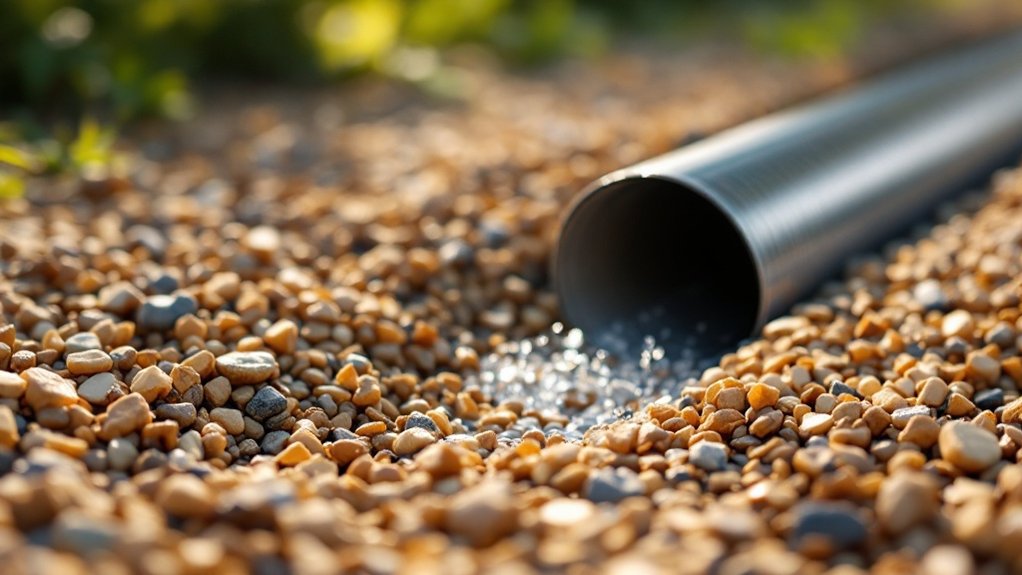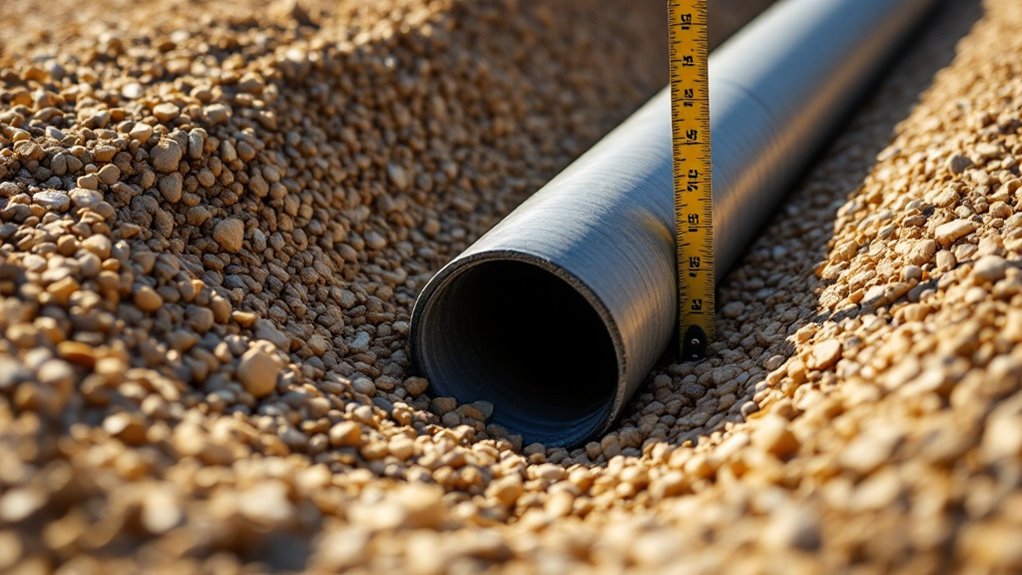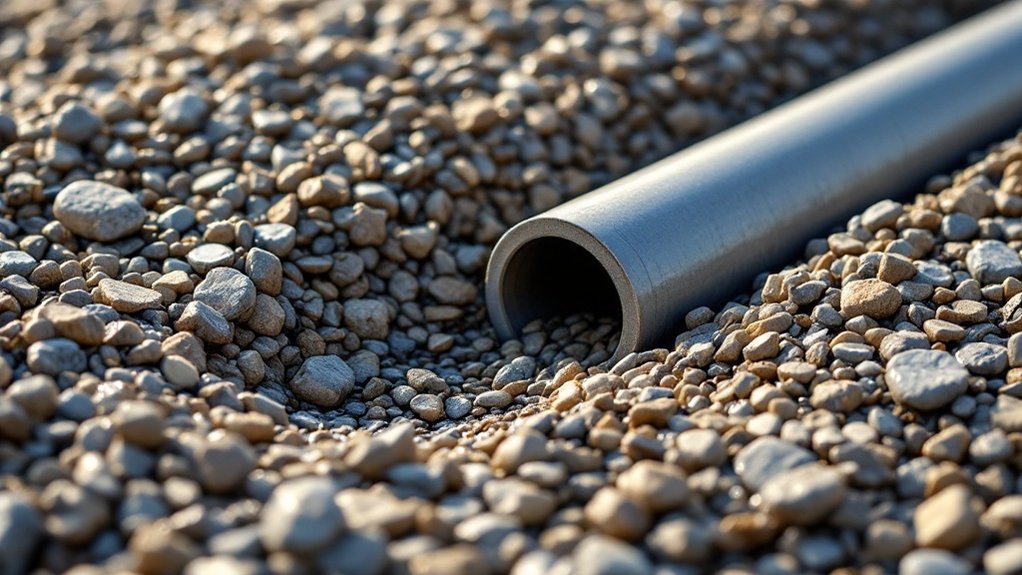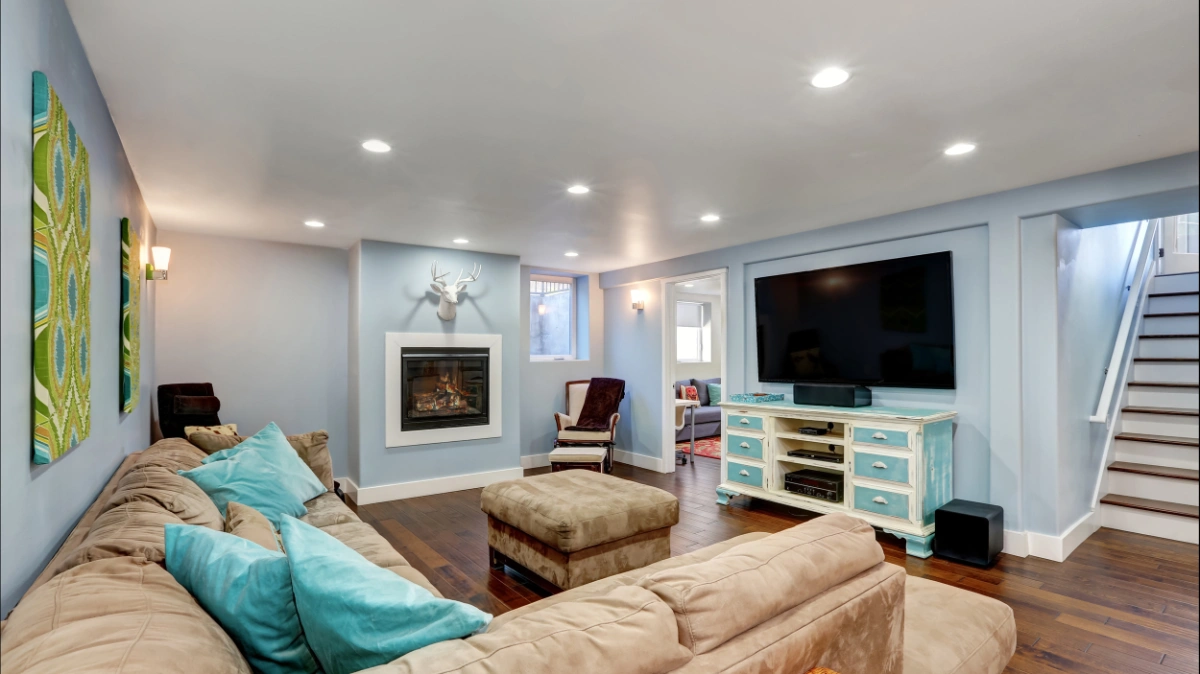For proper drainage pipe installation, you’ll need gravel both beneath and above the pipe. Place a minimum 3-4 inch gravel bed below the pipe, then add gravel extending at least 3 inches above the pipe’s crown. The trench should be 6 inches wider than the pipe on each side. Choose angular crushed stone (#57 or #8) or pea gravel (3/8″-3/4″) for ideal drainage. Proper material selection and installation techniques prevent common failures that compromise your entire drainage system.
Key Takeaways
- Place a minimum of 3-4 inches of gravel beneath drainage pipes for proper foundation and support.
- Install at least 6 inches of gravel coverage on the sides and top of drainage pipes.
- Use angular crushed stone (#57 or #8) rather than rounded river rock for better stability.
- Extend the trench at least 6 inches wider on each side of the pipe for adequate drainage.
- Wrap both pipe and surrounding gravel in geotextile fabric to prevent soil from clogging the system.
Recommended Gravel Depths for Different Drainage Applications

When installing drainage pipes, proper gravel depth is essential for ensuring ideal water flow and system longevity.
For residential applications, surround pipes with 4-6 inches of gravel, while French drains require 8-12 inches to handle larger water volumes.
Your pipe should rest on a gravel bed at least 3-4 inches deep, filling one-third of the trench depth.
Always ensure your drainage pipe sits on a 3-4 inch gravel foundation that comprises one-third of your total trench depth for optimal performance.
For pipe-free systems, fill two-thirds with larger gravel (1½ inches or more).
Heavy-duty drainage beneath driveways needs at least 6 inches of crushed stone, while surface applications like walkways require only 3-4 inches of gravel drainage material. Additionally, considering stormwater management is crucial to prevent flooding and optimize drainage performance.
Calculating the Proper Gravel-to-Pipe Ratio

How do you guarantee ideal drainage performance? Adhere to a specific gravel-to-pipe ratio that optimizes drainage efficiency.
For most applications, install a minimum 1-inch gravel bed beneath your pipe, with 3 inches of coverage above. Larger diameter pipes require proportionally more gravel for stability.
Proper gravel compaction around the pipe is critical—compact beneath and alongside the pipe, but avoid excessive compaction above that could damage it.
The surrounding gravel should create a continuous pathway for water movement while protecting the pipe from soil intrusion and shifting.
Consider your soil type and drainage area when determining final gravel quantities.
Best Gravel Types and Sizes for Effective Drainage

Three critical factors determine drainage efficiency around pipes: gravel type, size, and shape.
For ideal gravel drainage techniques, select angular materials like crushed stone (#57 or #8) that create stable channels for water flow while resisting compaction. Pea gravel (3/8″ to 3/4″) offers excellent permeability for residential applications.
Your gravel material selection should prioritize hard rocks such as granite or basalt for longevity.
For superior drainage durability, select granite or basalt gravel that withstands years of ground pressure and water exposure.
Maintain gravel sizes between ½” and 1½” to prevent settling issues while maximizing flow capacity.
Avoid river rock for critical drainage applications, as its rounded shape reduces water movement efficiency despite its decorative appeal.
Trench Dimensions and Proper Gravel Layering Techniques
Proper trench dimensions and gravel layering form the foundation of effective drainage system performance. Your trench should extend at least 6 inches wider on each side of the pipe, with depth providing uniform bearing support.
Maintain trench safety by limiting open excavation to 200 feet maximum.
For ideal drainage, place minimum 6 inches of gravel beneath the pipe and extend the gravel layer 12 inches above the pipe crown.
When using excavation techniques near existing utilities, keep width at practical minimum while ensuring proper compaction. Compact gravel to 98% density to prevent settling and maintain structural integrity.
Creating the Optimal Slope and Foundation for Drainage Systems
When establishing an efficient drainage system, the slope of your pipe plays a critical role in determining overall performance. You’ll need a minimum slope of ¼ inch per foot, though requirements may range up to 3 inches depending on your specific application.
Calculate required elevation change by multiplying pipe length by desired slope. For example, a 20-foot pipe at ¼ inch per foot needs a 5-inch drop.
Proper foundation stability requires careful trench preparation with appropriate bedding materials beneath the pipe. Regular slope maintenance prevents clogs and backups.
A stable foundation demands meticulous trench work and quality bedding materials, while ongoing slope maintenance ensures uninterrupted flow.
Consider ground elevation changes when planning your route, and always direct drainage toward a designated outlet while maintaining consistent downward flow.
Common Mistakes to Avoid When Installing Gravel Around Pipes
You’ll greatly compromise your drainage system’s effectiveness if you use insufficient filtration fabric, which allows soil particles to infiltrate and clog the gravel bed surrounding your pipe.
Proper installation requires complete wrapping of the pipe and gravel assembly with geotextile fabric that extends at least 12 inches beyond each side with proper overlapping at seams.
The natural settling of gravel over time must be anticipated during installation by adding 15-20% extra material to maintain adequate coverage and prevent pipe exposure or system failure.
Insufficient Filtration Fabric
A critical yet often overlooked component in drainage pipe installations, filtration fabric serves as the essential barrier between soil and your drainage system.
When you neglect proper filter fabric installation, soil particles infiltrate your gravel layer, reducing drainage efficiency and leading to eventual system failure.
The most effective approach is implementing the “Burrito Wrap” method—placing lightweight non-woven geotextile fabric throughout the trench before adding gravel.
Guarantee generous overlapping where fabric meets pipes to eliminate potential entry points for sediment. This prevents soil contamination while allowing water to pass freely through the drainage system, greatly extending its lifespan and minimizing maintenance requirements.
Ignoring Settling Effects
The natural settling process of gravel around drainage pipes represents one of the most overlooked yet critical factors in system longevity.
Without proper compaction, your drainage system will experience considerable settling consequences over time, creating voids that compromise structural integrity.
When you ignore compaction requirements, the initially even gravel distribution will shift, potentially creating low spots with poor drainage impact. This is particularly problematic under vehicular traffic areas, where the recommended 12-inch cover depth becomes insufficient after settling occurs.
Proper compaction prevents the formation of these voids, ensuring your French drain maintains its 1% slope grade for ideal water flow throughout its service life.




